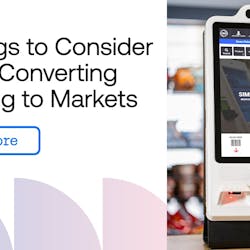There is so much talk these days of creating a work environment that encourages collaboration, conversation and ideas. One that is flexible, unique and fits the way employees work.
And many companies, large and small, are recognizing that employees don’t work the same way they did 20 years ago.
Rather than sitting static at a desk for 40 hours each week, employees are demanding workplace flexibility in terms of hours and location; in fact, many employees aren’t even using their assigned workspaces. Forbes reports that today’s employees want flexible workspaces that include lounge areas and a distraction-free environment, forcing companies to think about office design and how to use it to attract and retain top talent.
This is great news for operators offering micro markets, which can make breakrooms flexible and diverse – a meeting place for collaboration or solo work away from a standard desk. Micro markets can bring together the consumer’s desire for a café-like, open experience and the employer’s need for productivity and happy workers. If you’re not doing so now, it’s time to emphasize micro market layout and design.
Think about layout
Although operators might be regularly consulted about the layout of the breakroom, there may still be an opportunity to make the breakroom a unique shopping experience. When installing a micro market, the first things to look at are the restrictions: does the cooler have to be in a specific location? What about the kiosk? How many shelves do you need and what height should they be? Are there enough electrical outlets? The answers to these questions will determine the initial layout of the micro market.
Second, operators should consider the flow of the micro market. Did you ever notice that when you walk into a grocery store you are ‘led’ to specific sections? Generally produce is the first thing you see and you end up walking through most of the store to get to the refrigerated section. That’s not by accident. In a micro market, try placing the coolers – one of the most popular places for consumers to travel to – as far away from the entrance as possible, forcing the customer to walk past product and free-standing shelving full of promotional items and/or fresh fruit.
When a customer checks out at the kiosk, be sure to have gum, mints and ancillary items nearby to encourage impulse purchases, an idea used by c-stores and in other retail segments.
A new look, feel
The more welcoming a breakroom feels, the more likely an employee will want to spend time there. If a micro market has poor lighting, few or no places to sit and no hospitable features, it’s not likely to be a place where consumers will want to linger and work. If the location is willing, discuss adding an upgrade in tables and chairs near outlets so employees can stay and do work; add lounge chairs and wall décor such as paintings, new color and/or digital signage; and customize the breakroom to the location’s interests. Pay attention to lighting, particularly that the micro market looks inviting. LED lights in coolers not only help the products inside stand out, they also give the operator leverage to discuss energy-saving aspects of the micro market.
Create a space for a coffee bar, where consumers can add condiments to their purchases, set their product down and throw away wrappers, etc. And use freestanding shelving for a quick change in micro market design; they can be moved to direct traffic to a new product.
Evolution of the workspace
The workplace is evolving, as seen by company after company opting for more flexible work environments. While micro markets are fitting nicely into this new workplace trend, it’s not enough to place a market and leave. Operators should consider ways in which they can make their location’s breakroom into a destination – a café-like experience. The design of a micro market should not only attract the customer, it should encourage them to come back.





